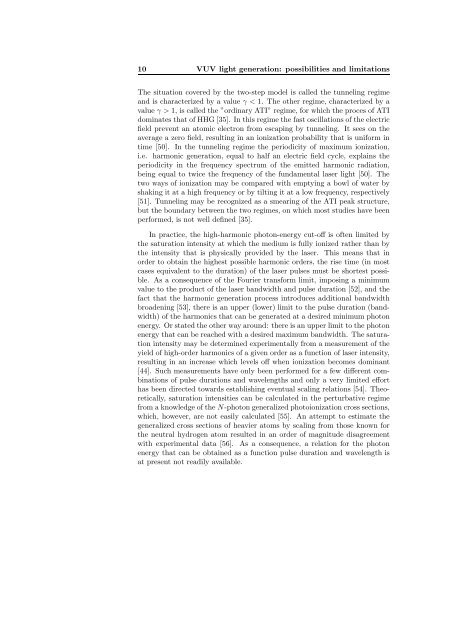VUV Spectroscopy of Atoms, Molecules and Surfaces
VUV Spectroscopy of Atoms, Molecules and Surfaces
VUV Spectroscopy of Atoms, Molecules and Surfaces
You also want an ePaper? Increase the reach of your titles
YUMPU automatically turns print PDFs into web optimized ePapers that Google loves.
10 <strong>VUV</strong> light generation: possibilities <strong>and</strong> limitations<br />
The situation covered by the two-step model is called the tunneling regime<br />
<strong>and</strong> is characterized by a value γ1, is called the ”ordinary ATI” regime, for which the proces <strong>of</strong> ATI<br />
dominates that <strong>of</strong> HHG [35]. In this regime the fast oscillations <strong>of</strong> the electric<br />
field prevent an atomic electron from escaping by tunneling. It sees on the<br />
average a zero field, resulting in an ionization probability that is uniform in<br />
time [50]. In the tunneling regime the periodicity <strong>of</strong> maximum ionization,<br />
i.e. harmonic generation, equal to half an electric field cycle, explains the<br />
periodicity in the frequency spectrum <strong>of</strong> the emitted harmonic radiation,<br />
being equal to twice the frequency <strong>of</strong> the fundamental laser light [50]. The<br />
two ways <strong>of</strong> ionization may be compared with emptying a bowl <strong>of</strong> water by<br />
shaking it at a high frequency or by tilting it at a low frequency, respectively<br />
[51]. Tunneling may be recognized as a smearing <strong>of</strong> the ATI peak structure,<br />
but the boundary between the two regimes, on which most studies have been<br />
performed, is not well defined [35].<br />
In practice, the high-harmonic photon-energy cut-<strong>of</strong>f is <strong>of</strong>ten limited by<br />
the saturation intensity at which the medium is fully ionized rather than by<br />
the intensity that is physically provided by the laser. This means that in<br />
order to obtain the highest possible harmonic orders, the rise time (in most<br />
cases equivalent to the duration) <strong>of</strong> the laser pulses must be shortest possible.<br />
As a consequence <strong>of</strong> the Fourier transform limit, imposing a minimum<br />
value to the product <strong>of</strong> the laser b<strong>and</strong>width <strong>and</strong> pulse duration [52], <strong>and</strong> the<br />
fact that the harmonic generation process introduces additional b<strong>and</strong>width<br />
broadening [53], there is an upper (lower) limit to the pulse duration (b<strong>and</strong>width)<br />
<strong>of</strong> the harmonics that can be generated at a desired minimum photon<br />
energy. Or stated the other way around: there is an upper limit to the photon<br />
energy that can be reached with a desired maximum b<strong>and</strong>width. The saturation<br />
intensity may be determined experimentally from a measurement <strong>of</strong> the<br />
yield <strong>of</strong> high-order harmonics <strong>of</strong> a given order as a function <strong>of</strong> laser intensity,<br />
resulting in an increase which levels <strong>of</strong>f when ionization becomes dominant<br />
[44]. Such measurements have only been performed for a few different combinations<br />
<strong>of</strong> pulse durations <strong>and</strong> wavelengths <strong>and</strong> only a very limited effort<br />
has been directed towards establishing eventual scaling relations [54]. Theoretically,<br />
saturation intensities can be calculated in the perturbative regime<br />
from a knowledge <strong>of</strong> the N-photon generalized photoionization cross sections,<br />
which, however, are not easily calculated [55]. An attempt to estimate the<br />
generalized cross sections <strong>of</strong> heavier atoms by scaling from those known for<br />
the neutral hydrogen atom resulted in an order <strong>of</strong> magnitude disagreement<br />
with experimental data [56]. As a consequence, a relation for the photon<br />
energy that can be obtained as a function pulse duration <strong>and</strong> wavelength is<br />
at present not readily available.















